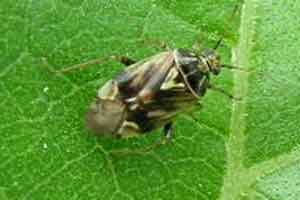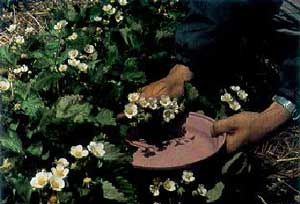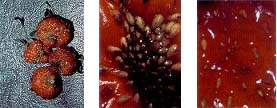Strawberry Insect Pests
Insects
Scouting Methods And Economic Spray Thresholds
As strawberry plants begin to flower, strawberry growers should be scouting their fields for signs of tarnish plant bug and clipper weevil activity. These two insects can cause major damage to strawberry flowers and buds, reducing yields significantly. Tarnish Plant BugThese can cause injury to foliage and fruit. Berry malformation is a result of feeding activity. Watch for adults on leaves and check blossom clusters for nymphs. Apply a recommended insecticide when bugs are active at first bloom and again about ten days later. Check for tarnished plant bug damage to foliage. (Little white flecks on leaves and/or leaves may curl up.) See the MAFRI Guide to Fruit Crop Protection for registered insecticides. MonitoringEarly monitoring of fields is important if damage is to be minimized. It is easily done using a standard, insect sweep net, being sure to sample throughout the field on a regular basis, starting at the bud stage. Growers often sample by tapping the blossom clusters of strawberry plants into shallow trays. This works fine for the nymphs (the most injurious stage). However, the adults fly quickly when disturbed and are often unseen. Because the adults can fly long distances, an outbreak may occur suddenly. Regular sampling and sweeping is needed to detect such infestations. CommentsBecause many weeds serve as alternate hosts, it is important to eradicate weeds in and near strawberry plantings. Because these insects sometimes overwinter in tall grass, any permanent sod should be mowed in late fall. They can be controlled in ornamental plantings by weed control and by keeping lawns or grassy areas mowed to eliminate breeding sites. If alfalfa is grown near strawberry fields, avoid cutting the alfalfa until after the strawberry fruit has been harvested. If cut before this time the insects that are infesting the alfalfa will move directly onto the strawberries. Tarnished Plant Bug (Lygus Bug)Tarnished plant bug Sampling for tarnished plant bug Cat-facing, achenes same size, and poor pollination (achenes smaller) Characteristics
Other causes of cat-facing
Tarnished Plant Bug Economic Thresholds
Clipper WeevilThe adult female punctures the flower bud and inserts an egg, then crawls down the stem and severs it. Watch for evidence of clipped buds. Recommended insecticides must be applied when buds are developing and at early bloom. See the MAFRI Guide to Fruit Crop Protection for registered insecticides. MonitoringVisual inspection is the easiest way to scout for this pest. Scout areas close to fence rows, shelterbelts and field margins, as these areas are most likely to suffer clipper damage. Clipper Weevil (Bud Weevil)Characteristics
Adult clipper weevil in flower, and clipped bud Images from OMAFRA except clipper weevil adult from Corn Extension Service and SPS from AAFC. Clipper Weevil Economic ThresholdOld threshold: 1.5 to 2 clipped buds per metre of row (1.3 buds per 2 ft2) New threshold: 15 to 20 clipped buds per metre of row (13 buds per 2 ft2) The new higher threshold is suggested as it was found that the plant compensates by producing smaller berries (may lose king berry), but more berries produced overall, which result in increased net yield. | |||||||||||||||||||||||||





